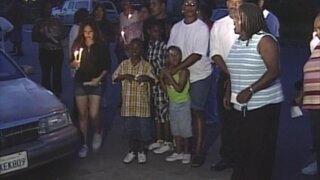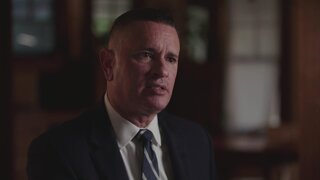'That’s A Lot Of Hate’: Dead Insects Lead Detectives To Man Who Killed 5 Family Members
To catch the killer who murdered Joanie Harper and her family, detectives had to show that a seemingly strong alibi was built on lies.
Years ago, a quintuple homicide sent shockwaves through Bakersfield, California. Five members of a family, including an infant, were brutally gunned down in their home — and the culprit was a loved one.
On July 8, 2003, officers responded to a frantic 911. “She’s laying on the bed, dead,” the caller is heard saying in a recording obtained by Oxygen's “Family Massacre."
The caller had gone to the home of Joanie Harper, 39, who two days earlier failed to show up for church.
Detectives determined that Joanie, her children, Marques, 4, Lyndsey, 23 months, and Marshall, 6 weeks, and her mother, Ernestine, 70, had been shot to death. Joanie was also stabbed.
“That’s a lot of hate,” said Donald Krueger, a detective in Bakersfield, California. “Five people, three generations being wiped out in one moment … It was like nothing else I'd dealt with.”
The Harper home appeared to have been ransacked, but valuables in plain sight including cash, credit cards, and a TV set were not taken. Detectives considered that the crime scene had been staged.
Autopsies showed that the murders had taken place after 1p.m. on Sunday, July 6.
Investigators dug into the victims’ backgrounds. Ernestine was a civil rights advocate who had felt the backlash of her activism. She owned a revolver for protection that was found near her body. Joanie, meanwhile, was a basketball official and a devout church-goer.
Detectives focused on individuals closest to the victims, including Joanie’s husband, Vincent Brothers, then 41, a high school vice principal. He was in Elizabeth City, North Carolina, where his mother lived.
They flew to North Carolina to interview Brothers on the evening of July 8. He had been informed of the murders and was waiting for the detectives at a police station. Brothers said he had come to his mother’s home directly from visiting his brother, Melvin, in Ohio.
“When I started to speak with him, he started to scream,” said Jeff Watts, a detective in Bakersfield, California. “It looked like he was going to vomit.”
The interview was going nowhere, so it was concluded and Brothers was released. However, investigators told “Family Massacre,” Brothers was still considered a person of interest until his alibi checked out.
And that alibi initially appeared to be secure. Detectives found Brothers' credit cards were used in Columbus on Sunday, July 6, the day of the murders. His cell phone was pinging in Ohio during the same period.
As investigators dug deeper they found that Joanie and Brothers were estranged at the time of the murders. Because of infidelity and other issues there was “bad blood” between them, witnesses said. While marital discord could be a murder motive, officials grappled to understand why a father would kill his children.
As investigators further scrutinized Brothers' credit card activity on July 6, cracks in the alibi emerged. Surveillance tapes from stores where purchases were made showed that Melvin Brothers had actually used the credit cards. Melvin initially denied using the cards, but reluctantly admitted that Vincent told him what to buy – and when to go shopping.
After punching a hole in part of Vincent’s alibi, investigators looked more closely at his out-of-town travel. Flight records confirmed that Vincent flew from Los Angeles to Ohio on July 2. He had plans to stay for a week or so. Melvin told officials that he didn’t see Vincent between July 5 and 8.
Investigators constructed a timeline of Vincent’s movements. Upon landing in Ohio, he rented a car. They found that Vincent had put 5,400 miles on the rental car odometer, which supported their theory that he made a round-trip drive from Ohio to California in time to kill his family.
Reviewing the car’s rental history, detectives knew that the vehicle hadn’t been driven west of Michigan. Investigators teamed up with the FBI and sent the rental car’s radiator and air filter to UC Davis for some out-of-the-box analysis.
Detectives believed that insect remains received from the auto parts would reveal a detailed history where the car – and Vincent – had traveled. Certain bugs are only found in certain parts of the U.S.
UC Davis entomologist Dr. Lynn Kimsey found a number of insects including a type of wasp and grasshopper indigenous to areas west of the Rocky Mountains in the vehicle.
“We knew that the rental car was in Bakersfield or at least in the greater southern California area,” investigators told producers. To build their case, detectives reached out to the Bakersfield community. They were able to confirm that Vincent had been seen during the time the murders occurred.
“Through further investigation, we learned Vincent was quite the ladies man,” said Watts. “Many of those relationships were concurrent and they were occurring months before the murders.” There was also evidence of domestic violence in earlier relationships, said Krueger.
A decade before the murders he’d gone to court to reduce his child support payments. Investigators seized upon that as a possible motive for the mass murder.
In April 2004, Vincent Brothers was charged with five counts of first degree murder and a special charge because of the multiple homicides. His trial began in January 2007. It lasted four months, and the jury deliberated for three days, according to investigators.
Vincent Brothers was found guilty on all counts. On September 27, 2007, he was sentenced to death. He is currently on death row in San Quentin prison.
To learn more about the case, watch “Family Massacre,” streaming now on Oxygen.com.

































